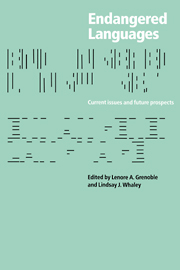Book contents
- Frontmatter
- Contents
- Preface
- List of abbreviations and symbols
- Part I General issues
- 1 Western language ideologies and small-language prospects
- 2 Toward a typology of language endangerment
- Part II Language-community responses
- Part III What is lost: language diversity
- Part IV Mechanisms of language loss
- Appendix
- References
- Index of languages
- Index of names
- General index
2 - Toward a typology of language endangerment
Published online by Cambridge University Press: 05 June 2012
- Frontmatter
- Contents
- Preface
- List of abbreviations and symbols
- Part I General issues
- 1 Western language ideologies and small-language prospects
- 2 Toward a typology of language endangerment
- Part II Language-community responses
- Part III What is lost: language diversity
- Part IV Mechanisms of language loss
- Appendix
- References
- Index of languages
- Index of names
- General index
Summary
The fundamental cause for the disappearance of a human language is well known. Speakers abandon their native tongue in adaptation to an environment where use of that language is no longer advantageous to them. This much about language death is simple and uncontroversial. The more complex, and thus obscure, issue is “What brings about the decreased efficacy of a language in a community?” A sufficient answer involves outlining an intricate matrix of variables dealing with the community's self-identity, its relationship with other groups, the degree of political autonomy of the group, its access to avenues of material prosperity, etc. Due to the complexities of the issue, most comparative work on threatened languages seeks out general points of commonality between situations, rather than distinctness, and rightly so. By identifying recurrent patterns in the causes of language decline, such work has helped make manifest those characteristics of speech communities which leave them most susceptible to language loss.
However, the focus on shared characteristics often masks the fact that there are intriguing divergences from the typical scenario for language loss: individual speech communities which have resisted language shift against all expectations, as well as regions of the world which do not fit smoothly into the general picture which has been drawn for language endangerment. The focus on similarities also begs important questions such as: why do linguistically related groups with similar histories and demographics manifest significantly different rates of language obsolescence?
- Type
- Chapter
- Information
- Endangered LanguagesLanguage Loss and Community Response, pp. 22 - 54Publisher: Cambridge University PressPrint publication year: 1998
- 52
- Cited by

